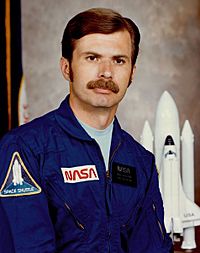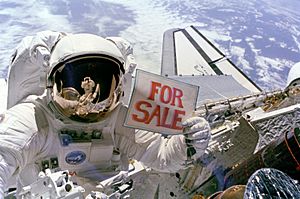Dale Gardner facts for kids
Quick facts for kids
Dale A. Gardner
|
|
|---|---|
 |
|
| Born | November 8, 1948 Fairmont, Minnesota, U.S.
|
| Died | February 19, 2014 (aged 65) Colorado Springs, Colorado, U.S.
|
| Other names | Dale Allan Gardner |
| Alma mater | UIUC, B.S. 1970 |
| Occupation | Naval Flight Officer |
| Awards | Defense Superior Service Medal (3) NASA Space Flight Medal (2) Distinguished Flying Cross Meritorious Unit Commendation Humanitarian Service Medal Sea Service Deployment Ribbon Master Space Badge Lloyd's of London Meritorious Service Medal |
| Space career | |
| NASA Astronaut | |
| Rank | |
|
Time in space
|
14d 00h 52m |
| Selection | 1978 NASA Group 8 |
|
Total EVAs
|
2 |
|
Total EVA time
|
12 hours 14 minutes |
| Missions | STS-8, STS-51-A |
|
Mission insignia
|
|
| Retirement | October 1986 |
Dale Allan Gardner (born November 8, 1948 – died February 19, 2014) was a brave NASA astronaut. He was also a naval flight officer and flew on two exciting Space Shuttle missions in the 1980s.
Contents
About Dale Gardner
Dale Gardner was born on November 8, 1948, in Fairmont, Minnesota. He grew up in Sherburn, Minnesota, and Savanna, Illinois. He thought of Clinton, Iowa, where his mother lived, as his hometown. Dale enjoyed many sports and hobbies. These included snow skiing, golfing, tennis, woodworking, and photography. He lived with his second wife, Sherry, in Colorado until he passed away. He is remembered by his daughter, grandchild, and sisters.
His Education
Dale Gardner was a very smart student. He graduated at the top of his class from Savanna Community High School in Savanna, Illinois, in 1966. He then went to the University of Illinois at Urbana-Champaign. In 1970, he earned a Bachelor of Science degree in Engineering Physics.
Military Career
After college in 1970, Dale Gardner joined the United States Navy. He went to Aviation Officer Candidate School in Pensacola, Florida. He was chosen as the most promising naval officer from his class. In October 1970, he started training as a Naval Flight Officer. He had the highest academic score ever in his squadron!
On May 5, 1971, he earned his Naval Flight Officer wings. From 1971 to 1973, he worked at the Naval Air Test Center in NAS Patuxent River, Maryland. There, he helped test the new F-14 Tomcat fighter jet.
Later, he joined the first F-14 squadron (VF-1) at Naval Air Station Miramar, California. He flew the Tomcat on two trips across the Pacific Ocean and Indian Ocean aboard the aircraft carrier USS Enterprise. Before becoming an astronaut, he also tested Navy fighter aircraft.
Becoming a NASA Astronaut
NASA chose Dale Gardner as an astronaut in January 1978. He started training at the Johnson Space Center in July 1978. After a year of training, he became a Mission Specialist Astronaut in August 1979.
He helped with the computer software for the Space Shuttle before its first flight in April 1981. He also supported the fourth Shuttle flight (STS-4). Dale Gardner flew as a mission specialist on two Space Shuttle missions:
- STS-8 (August 30 to September 5, 1983)
- STS-51-A (November 8–16, 1984)
He spent a total of 337 hours in space. During his missions, he orbited the Earth 225 times. He also flew over 2,300 hours in more than 20 different types of aircraft.
After 8½ years with NASA, Dale Gardner returned to the United States Navy in October 1986. He worked at the U.S. Space Command in Colorado Springs, Colorado. He helped track objects in Earth orbit and protect U.S. space systems. He retired from the Navy in October 1990 as a captain.
After the Navy, he worked for companies like TRW Inc. and Northrup Grumman. He helped develop space and defense technology. In 2003, he joined the National Renewable Energy Laboratory. He retired from there in January 2013.
Space Shuttle Missions
STS-8: First Night Launch and Landing
STS-8 launched from the Kennedy Space Center, Florida, on August 30, 1983. Dale Gardner was a mission specialist on the Space Shuttle Challenger. This was the first time a Space Shuttle launched and landed at night!
During the mission, the crew:
- Deployed the Indian National Satellite (INSAT-1B).
- Tested the Canadian-built Remote Manipulator System (RMS) robot arm.
- Did many experiments about Earth's resources and space science.
STS-8 orbited Earth 98 times. The mission lasted 145 hours before landing in California on September 5, 1983.
STS-51-A: Satellite Rescue Mission
STS-51-A launched on November 8, 1984, which was Dale Gardner's birthday! He flew on the Space Shuttle Discovery.
On this mission, the crew:
- Deployed two satellites: Canada's Anik D-2 and the U.S. Navy's LEASAT-1.
- Performed an amazing rescue! They found and brought back two satellites that had been launched into the wrong orbits. These were the Indonesian Palapa B-2 and the Western Union Westar VI satellites.
Dale Gardner and fellow astronaut Joseph Allen did two spacewalks to complete this rescue. Their spacewalks lasted over 12 hours! They even used the Manned Maneuvering Unit (MMU) backpack during the rescue. STS-51-A completed 127 orbits of Earth. It landed at the Kennedy Space Center on November 16, 1984.
Awards and Honors
Dale Gardner received many awards for his service. Some of his top honors include:
- Defense Superior Service Medal (three times)
- Distinguished Flying Cross
- NASA Space Flight Medal (twice)
- Master Space Badge
- Lloyd's of London Meritorious Service Medal
In November 2017, a new bridge was built and named after him. The Dale Gardner Veterans Memorial Bridge connects Savanna, Illinois, and Sabula, Iowa, over the Mississippi River. It also honors U.S. Veterans.
His Passing
Dale Gardner passed away on February 19, 2014, at his home. He was 65 years old.
See also
 In Spanish: Dale Gardner para niños
In Spanish: Dale Gardner para niños


